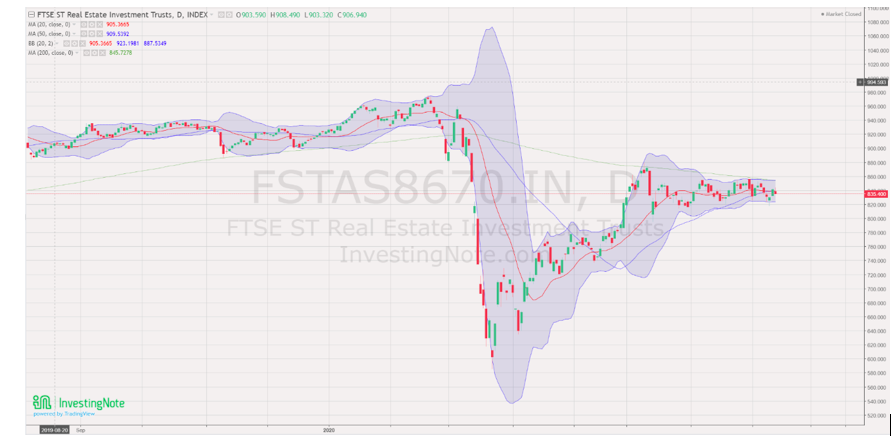- FTSE ST REIT Index has little changes from 837.43 to 835.40 (-0.35%) on the month update.
- REIT Index has rebounded c43% as of July 12 from the bottom on Mar 23, 2020.
- Yield spread (reference to 10-year Singapore government bond of 0.895%) has has increased from 4.414% to 5.665%.
- The risk premium is still attractive to accumulate Singapore REITs in stages to lock in the current price and long-term yield after the recovery.
- Technically the REIT Index is currently trading on sideway consolidation with low volatility until the breakout either above 860 resistance and 800 support. Current macro factors such as low interest rate environment and recovery of global economic support the bullish breakout.
Technical Analysis
Currently the REIT index is currently trading on sideway consolidation, sandwiched between 800 support and 860 resistance. There is a Bollinger Band Squeeze with very tight range and low volatility on FTSE ST REIT Index. The index can start big move in either direction.
Short term direction: Sideway.

Most Overvalued REITs
- Keppel DC REIT (Price/NAV = 2.50)
- Mapletree Industrial Trust (Price/NAV = 1.84)
- Parkway Life (Price/NAV = 1.82)
- Mapletree Logistic Trust (Price/NAV = 1.67)
- Ascendas REIT (Price/NAV = 1.62).
Most Undervalued REITs
- Eagle Hospitality Trust* (Price/NAV =0.17)
- ARA Hospitality Trust (Price/NAV = 0.44)
- Lippo Malls Indonesia Retail Trust (Price/NAV = 0.44)
- Starhill Global (Price/NAV = 0.55)
- Far East HT (Price/NAV = 0.58)
[*Eagle Hospitality Trust is currently suspended]
The Highest Distribution Yield (TTM)
- First REIT (11.09%)
- Lippo Malls Indonesia Retail Trust (10.83%)
- Prime US REIT (8.66%)
- Cromwell European REIT (8.59%)
- Keppel Pacific Oak US REIT (8.49%)
[ Reminder that these yield numbers are based on current prices taking into account delayed distribution/dividend cuts due to COVID-19. Some REITs opted for semi-annual reporting and thus no quarterly DPU was announced.]
The Highest Gearing Ratio REITs
- ARA Hospitality Trust (42.5%)
- ESR REIT (41.8%)
- Suntec REIT (41.3%)
- ARA Logos Log Trust (40.4%)
- OUE Commercial REIT (40.1%)
[ Singapore REIT has a gearing limit of 50%.]
Top 5 REITs with biggest market capitalisation
- Ascendas REIT (S$12.5)
- Mapletree Logistics Trust (S$8.1B)
- CapitaMall Trust (S$6.9B)
- Capitaland Commercial Trust ($6.3B)
- Mapletree Commercial Trust ($6.3B)
The bottom 3 REITs with smallest market capitalisation
- Eagle Hospitality Trust (S$119M)
- BHG REIT (S$290M)
- ARA Hospitality Trust ($264M)
[*Eagle Hospitality Trust is currently suspended]
Fundamental Analysis of 41 Singapore REITs
The chart below is the compilation of 41 REITs in Singapore with colour coding for the Distribution Yield, Gearing Ratio and Price to NAV Ratio. This gives investors a quick glance of which REITs are attractive enough to have an in-depth analysis. [Source: https://stocks.cafe/kenny/advanced.]
• Note 1: The Financial Ratio are based on past data and there are lagging indicators.
• Note 2: This REIT table takes into account the dividend cuts due to COVID-19 outbreak. Yield is calculated trailing twelve months (TTM), therefore REITs with delayed pay-outs might have lower displayed yields.
• Noted 3: Distribution Yield, NAV, Gearing Ratio would probably be adjusted moving forward.
• Note 4: Some REITs opted for semi-annual reporting.
• Note 5: Monetary Authority of Singapore (MAS) has raised the Gearing Limit from 45% to 50% on April 16, 2020. The implementation of Interest Coverage Ratio (ICR) > 2.5x has been deferred to Jan 1, 2022.
• Price/NAV decreased from 0.93 to 0.92 (Singapore Overall REIT sector is very undervalued now).
• Distribution Yield iccreased from 5.31% to 6.56% (take note that this is lagging number). About 43.9% of Singapore REITs (18 out of 41) have Distribution Yield > 7%. Do note that these yield numbers are based on current prices taking into account delayed distribution/dividend cuts due to COVID-19.
• Gearing Ratio increased slightly from 36.47% to 36.61%. In general, Singapore REITs sector gearing ratio is healthy. Note: Gearing may be affected (i.e. potential increase) as the valuation of the portfolio would be reduced.







